
Thursday, October 1, 2020
Inventions
We just can’t get away from them, now, can we? Alloys. As mentioned in previous newsletters, we create new things, new concepts, new relationships from the connections we make between inventions that came before us.
From the “Creative Alloys” issue of my newsletter a month ago:
The nugget that triggers your interest and your research on that nugget are
not original to you, but your creation from these resources becomes an alloy
that is original. We all build from what came before, but the product is our own
… when elements connect in a meaningful new awareness or understanding.
How often have we seen an invention sweep the world, only to learn decades later that someone brainstormed the concept decades before? Often by a person unrelated to the one credited with the invention?
Many times, too, an invention is not unique to one individual. The old adage states that “Necessity is the mother of invention.” Two or more individually employ an item in a new way, and separately figure out how to improve the item or broaden its application.
In science, the occurrence of creatures that look alike but aren’t is called “convergent evolution” – when non-related organisms evolve extremely similar characteristics in completely different environments. They look alike but they may not have similar needs, behavior, effects, or purposes.
Inventions with similar intended uses produced by unrelated inventors might be called “coincidental evolution.” “Great minds think alike,” after all. (This proverb, often tongue-in-cheek, dates to the early 17th century; the notion itself is ancient.)
Today we explore a few inventions, some coincidental, some not.
Sally M. Chetwynd
Brass Castle Arts
Email Me | Visit Website | Sign Up For Newsletter
To Tease Your Mind
To invent, you need a good imagination and a pile of junk.
Thomas A. Edison
(1847 – 1931)
A patent, or invention, is any assemblage of technologies
or ideas that you can put together that nobody put
together that way before. That’s how the patent office
defines it. That’s an invention.
Dean Kamen
(1951 – )

We know much about Thomas Edison, America’s greatest inventor, innovator, and businessman, whose genius rendered a major influence on our modern industrialized world. He held 1,093 US patents and many in other countries. An early job in a telegraph office generated his lifelong interest in electrical devices.
Most of us know far less about Dean Kamen, American engineer, inventor, and entrepreneur, who has been called the next Thomas Edison. He holds over 450 patents, many for electronic devices in the medical field. He is best known for his Segway Human Transporter, a battery-powered, two-wheeled scooter controlled by the rider’s posture and body movements. An early invention was the iBot, a self-balancing, battery-powered wheelchair designed to travel safely over uneven surfaces and terrain. He also founded FIRST – For Inspiration and Recognition of Science and Technology – an organization that promotes student interest in the sciences (STEM education).
Natterings & Noodlings: Inventions
Windows
Microsoft Windows is an electronic operating system used for data processing in many devices in today’s digital world, including personal computers, tablets, laptops, and smartphones. The idea of “windows” is that a user can work on and view more than one software program at a time, a “window” for each open at the same time between which the user toggles.
A couple of hundred years before Bill Gates and company came up with this idea, however, Thomas Jefferson invented a device that served his research needs in a similar way, albeit mechanically.
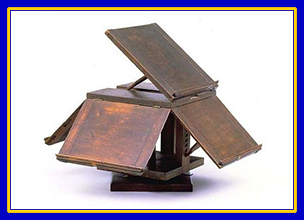
Jefferson was always doing research – writing books, Declarations, and Constitutions to commonwealths and colleges. To reduce clutter on his desk, he designed and constructed a revolving bookstand, supported by a lazy Susan turntable. Box-shaped, it has a hinged panel on each of four sides that can be raised from its folded-down position to hold a book angled for easy viewing, open to any place one is studying. A light push of a finger rotates the device to any one of the open books.
Phillip and I saw this original book stand when we visited Jefferson’s home, Monticello, on our honeymoon way-back-when. Jefferson never patented any of his inventions (which were many) because he believed that such things, beneficial to mankind in any endeavor, should be shared freely. (The Monticello museum store offers a reproduction for upwards of $600.)
I have found in my own research on things of a historical nature that I would appreciate having one of these, because of the many out-of-print and often obscure books I’m always digging into. Most of our home library is not online. And the content of books is rarely available without buying the book, which we already have. Nothing can replace the ability to check a book’s index and go directly to the needed passage without having to sort through 859,314 Google-search listings.
The Laptop
In May 2020, I received a post from “Murder Books,” a group of writers of authentic crime fiction whose members are professionals in law enforcement and criminal justice. This post, “A PI’s Tools of the Trade,” describes how one private investigator has equipped his car to function as an office. Besides the ubiquitous camera, he carries a laptop, a printer, a file cabinet, and many other accessories for efficient on-the-road work.

In research for my current WIP (work-in-progress), I discovered that a prototype of the laptop was invented around 1960. My non-fiction book is founded on the death of Maine State Police Trooper Charles C. Black in 1964, murdered when he responded to a bank robbery in South Berwick, Maine. Trooper Black’s widow, Mary, has provided many personal and professional details about her husband. One of these details is the typewriter he kept in his cruiser.
Among other things, Trooper Black was a meticulous man. In the ordinary course of his day, his activity log collected items for which he had to submit reports for the police department’s records. Idle time in the cruiser happened a lot, and rather than twiddle his thumbs, he put this time to good use, typing up his reports. (Otherwise, he would have had to do them at troop headquarters after his shift, and he’d rather spend the time romping with his two little boys at home before their bedtime.) He acquired a small portable manual typewriter, secured it to a piece of plywood, and kept it in the car.
Voila! The first laptop – two decades before the earliest electronic laptop computers became commercially available. Osborne, Epsom, Compaq, Grid Compass, Sharp, and many other companies launched modern models of the electronic laptop throughout the 1980s.
Trooper Black’s high-school pal and MSP colleague, Captain Reynold LaMontagne, now retired, confirmed this. He well remembers Black’s little typewriter. “The boys in Troop A, we used to poke fun at him all the time about that typewriter, but he’d just grin at us and ignore our jabs.”
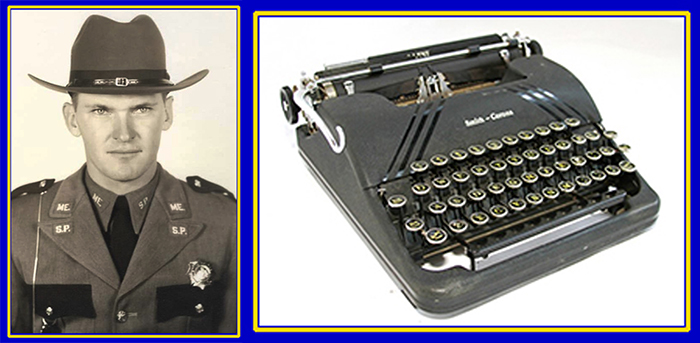
I had a small Smith-Corona typewriter like this one, which I purchased right after college. It was pricey for the times – mid 1970s, over $200, if I remember correctly. I used it day in and day out, typing up drafts of the Great American Novel (of which I eventually published two) and other writings, endless minutes (hours?) of the meetings of various groups I belonged to and newsletters of same, notes on my own research into historical interests, and … It went on forever. By the time we acquired a personal computer in the mid-1990s, the poor old thing suffered a ground swell – the lines of type rising and falling across the paper – and a few skipped keys, so it was time for retirement.
Typewriters are enjoying a resurgence of popularity. Although they can’t store data, they provide great exercise for the fingers and hands. (Check out the highly aerobic exercise that Archy the cockroach got, typing poems and letters every night in the news office where he had previously worked (as a man). Archy and Mehitabel, Don Marquis, 1927)
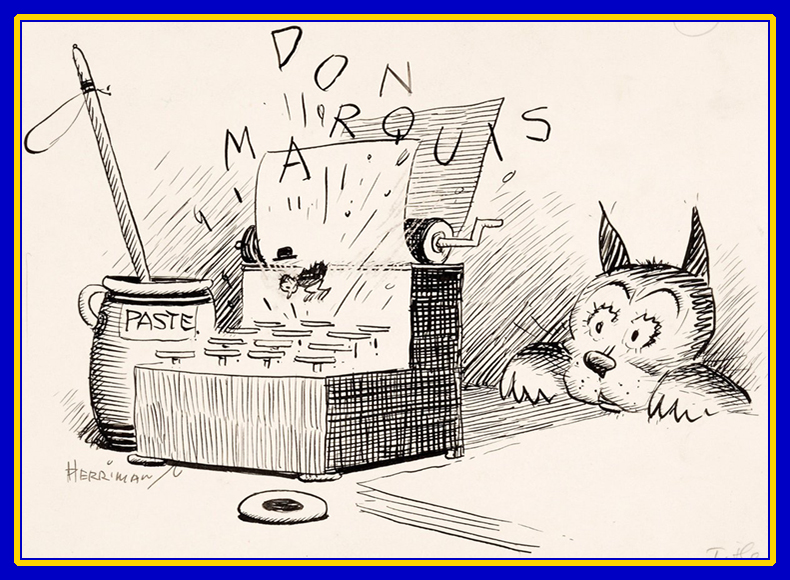
In this illustration by George Herriman (the creator of Krazy Kat and other cartoon characters), Archy is seen in the act of typing, working up quite a sweat, while Mehitabel the cat watches. (Mehitabel insists that her previous incarnation was Cleopatra.)
Chinese Finger Trap
Remember the Chinese finger trap? It is a toy made from diagonally woven strips that you put your fingers in. The harder you pull to get them out, the tighter the toy grasps them. It began as a defensive weapon (sort of) and was later redesigned as a toy, which even later inspired the design of a medical device.
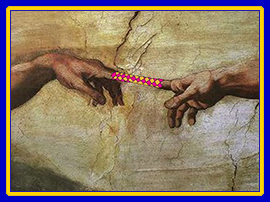
According to one fable, Lao Tzu used this device to confuse and subdue attacking aliens, and to trap prisoners of war and traitors. Another online source states that it was used by Chinese emperors to determine the worthiness of government representatives to hold office – those who pulled angrily were not worthy, and those who remained calm were considered suitable. (One online site credits Joseph D. Antoni of Queens, New York, with inventing it, but it turns out that he invented a cat’s-cradle string puzzle by that name, not the device we are talking about here.)
Some sources consider Lao Tzu to be a mythical figure (his mother conceived him when she saw a falling star, carried him for 62 years in her womb, and bore him fully grown with a gray beard). Others identify him as a real person, a 6th Century BC Chinese philosopher and writer of the Tao Te Ching. (It would seem that more than one Lao Tzu existed.)
Never mind the facts or legends. The available evidence points to the original finger trap as being of ancient Chinese origin. I think I’ve seen stuff about tiny knives installed in early traps, which cut the victim’s fingers (maybe off!). (Oooo … nothing to fool with.)
At some time in the 19th Century, the toy was developed from no-fun to fun. It was first made of bamboo strips, but those available today are usually made of paper or plastic, their strips often of contrasting colors.
In 1870, a student of Viennese dentist Dr. Steinberger had an idea to redesign the trap for use as a traction device in orthopedic medicine. Steinberger promoted the idea, and it was quickly adapted for use in surgery. By 1873 was given its own medical name, a German mouthful that means “finger trap.”
I was fortunate that the local hospital had one of these on hand when I broke my arm in February. It took half an hour for the staff in the ER to unearth the contraption. They didn’t remember if they still had it, and if not, would have to send to Mass General Hospital to borrow one, but they located it in a closet and brought it to my curtained bay. It looked like a medieval torture device. A series of five metal-wire finger traps hung from a frame supported on an adjustable-height stand on wheels.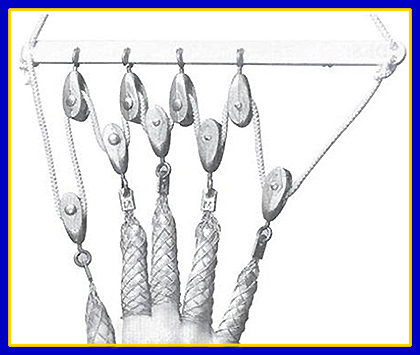
My fingers and thumb were inserted into the traps and the frame was raised so my arm was suspended vertically above my body (as I lay flat on the gurney bed). Four saline-solution bags were taped together and draped over my upper arm to provide weight. Gravity, enhanced by the saline-bag weights, gently pulled the broken bones back into their proper position.
Having received a pain-relieving injection before the finger trap was applied, I found the mechanics of the device fascinating, my engineering genes proving true to form. I studied it at length despite my drugged condition. The hospital’s implement looked a lot more archaic than in the illustration here, but the basic design was the same. When my arm was ready for splinting, the doctor pinched a small catch at the top of each trap to release each finger.
Ingenious! I love this kind of stuff!
A Website With Books Worth Checking Out
Typo Squad
 Stephen Lomer
Stephen Lomer
https://www.typo-squad.com
https://www.facebook.com/typosquadhome/
http://www.portninepublishing.com/index.html
Lomer has a real obsession about spelling words correctly. He has indulged this passion by writing several spoofy books that romp through the adventures of Dick Shonnary and his colleagues of Typo Squad. The agency is dedicated to protecting the world from the evils of errorism by destroying rampant errorist cells. A single typographical error can render anyone who reads it insensible for hours. It can be fatal in some cases.
Stephen posts photographs of typos, harvested locally and online, on his website and his FaceBook page. He accepts contributions of same, for the amusement and horror alike of fans and followers, friends and enemies.
Besides Typo Squad, Stephen operates Port Nine Publishing, which publishes fiction and short-story collections in a number of genres, including science fiction, horror, speculative fiction, and literary fiction. “Tell Me About Your Damned Book” is part of Port Nine, in which he interviews local authors. In May 2019 I was honored to be his guest as we talked about my second novel The Sturgeon’s Dance. Lomer laces his interviews with humor and irreverence, even if neither the author nor his or her book is funny.
He also writes novellas and short stories. Dark humor or light humor, they’re all fun!
Conversations
Do you have comments or questions about this post?
I’d love to hear them. Let’s talk!
Happy reading! Happy writing!
Sally
Sources & Credits
Image: Thomas Edison
http://content.time.com/time/specials/packages/article/0,28804,1999143_1999202_1999203,00.html
Image: Dean Kamen
https://www.thoughtco.com/dean-kamen-profile-1992041
https://en.wikipedia.org/wiki/Dean_Kamen
Image: Thomas Jefferson’s revolving book stand
https://www.monticelloshop.org/monticello-revolving-bookstand/
Image: “A PI’s Tools of the Trade” Ben Keller
https://murderbooks.wordpress.com/2020/05/12/a-pis-tools-of-the-trade/
History of the laptop
https://en.wikipedia.org/wiki/History_of_laptops
Image: Maine State Police Trooper Charles C. Black
courtesy of Mary Black Andrews & Charles C. Black II
Image: SCM Silent 1946 typewriter – Smith-Corona Typewriter Museum
https://www.smithcorona.com/blog/portfolio-items/post-war-and-the-1950s/
Image: Don Marquis’s Archy and Mehitabel (1927)
https://en.wikipedia.org/wiki/Archy_and_Mehitabel
Image: Medical finger trap
https://www.devineexpress.com/products/32500000-zimmer-finger-traction-kit-5-finger-traps-stainless-steel-mesh-pulleys-suspension-bar?variant=15648119291947&cmp_id=1705750308&adg_id=66027571625&kwd=&device=c&gclid=EAIaIQobChMI95TikcWH7AIVAobICh3YzAGWEAQYAiABEgKmnPD_BwE
Lao Tzu
https://en.wikipedia.org/wiki/Laozi
finger-trap medical traction device – 1870
https://en.wikipedia.org/wiki/Chinese_finger_trap
Lazy Susan
https://en.wikipedia.org/wiki/Lazy_Susan
Image: Stephen Lomer’s Typo Squad
https://www.typo-squad.com/the-books.html



